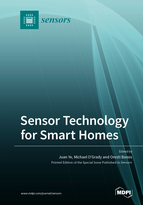Sensor Technology for Smart Homes
A special issue of Sensors (ISSN 1424-8220). This special issue belongs to the section "Sensor Networks".
Deadline for manuscript submissions: closed (15 October 2020) | Viewed by 50346
Special Issue Editors
Interests: Privacy; Activity Recognition; Wearable computing
Special Issues, Collections and Topics in MDPI journals
Interests: ambient intelligence; pervasive computing; ubiquitous sensing
Special Issues, Collections and Topics in MDPI journals
Interests: wearable, ubiquitous, and mobile computing; artificial intelligence; data mining; digital health
Special Issues, Collections and Topics in MDPI journals
Special Issue Information
Dear Colleagues,
With the relentless advance in sensing technologies, we are witnessing an increasing number of sophisticated smart home deployments covering a wide spectrum of applications including health monitoring and home automation. However, the inherent complexity of real-world deployment is significantly challenging current smart home systems; such complexity includes the inherently imperfect nature of sensing technologies, the dynamic nature of human behaviour, and the unpredictability of situations or events occurring in the home. Various problems accrue as a result of such complexity; these include decreased accuracies in recognising human activities over time and subsequent degradation of the performance of smart home systems with negative implications for user experience.
The objective of this Special Issue is to present the state-of-the-art in sensing technologies for the smart home; document realistic experiences of long-term, real-world smart home deployments; explore novel intelligent algorithms to discover and adapt smart home systems to changes in human daily routines and other contexts; and present new research challenges and opportunities in the smart home domain.
Original, high-quality contributions from both academia and industry are sought. Manuscripts submitted for review should not have been published elsewhere or be under review by other journals or peer-reviewed conferences.
Topics of interest include, but are not limited to, the following:
- Novel sensing technologies for smart homes;
- Standardisation initiatives applicable to smart homes;
- Internet of Things approaches for smart homes;
- Privacy, security, and data management within smart homes;
- User experiences of smart home technologies;
- Human activity recognition, both predictive and in near real time;
- Interaction design and novel user interfaces for smart homes;
- Approaches to modelling computational and social intelligence within smart homes;
- Novel applications and services for the smart home;
- Smart homes and their inter-relationship with smart cities.
- The lifelong learning of occupant behaviour in smart home systems;
- Human-centred learning in smart home systems;
- Methodologies for benchmarking smart home platforms and services;
- Ethical and privacy-preservation approaches to smart homes.
Dr. Juan Ye
Dr. Michael O'Grady
Dr. Oresti Banos
Guest Editors
Manuscript Submission Information
Manuscripts should be submitted online at www.mdpi.com by registering and logging in to this website. Once you are registered, click here to go to the submission form. Manuscripts can be submitted until the deadline. All submissions that pass pre-check are peer-reviewed. Accepted papers will be published continuously in the journal (as soon as accepted) and will be listed together on the special issue website. Research articles, review articles as well as short communications are invited. For planned papers, a title and short abstract (about 100 words) can be sent to the Editorial Office for announcement on this website.
Submitted manuscripts should not have been published previously, nor be under consideration for publication elsewhere (except conference proceedings papers). All manuscripts are thoroughly refereed through a single-blind peer-review process. A guide for authors and other relevant information for submission of manuscripts is available on the Instructions for Authors page. Sensors is an international peer-reviewed open access semimonthly journal published by MDPI.
Please visit the Instructions for Authors page before submitting a manuscript. The Article Processing Charge (APC) for publication in this open access journal is 2600 CHF (Swiss Francs). Submitted papers should be well formatted and use good English. Authors may use MDPI's English editing service prior to publication or during author revisions.
Keywords
- Sensing technologies
- Intelligence systems
- Context reasoning
- Intelligent user interfaces
- Smart environments









